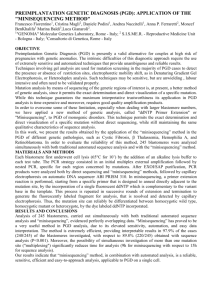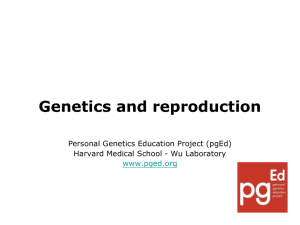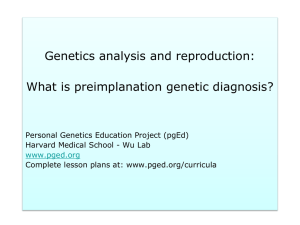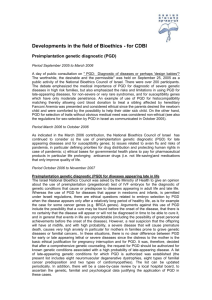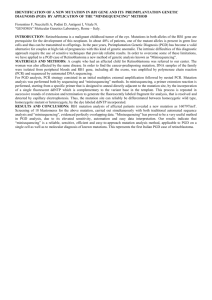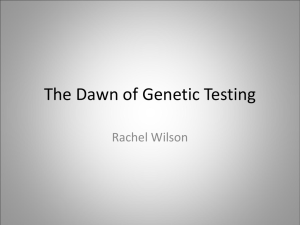Blondes Have More Fun . . . How Far Can... By Laura V. Yaeger J.D., L.L.M. Candidate
advertisement
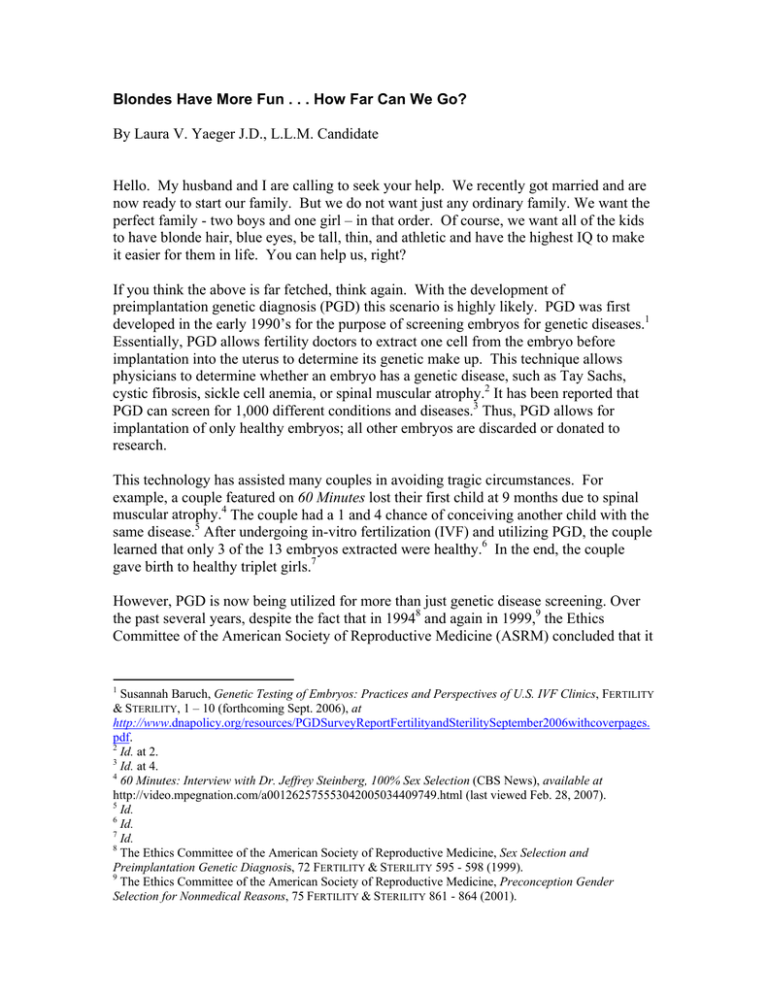
Blondes Have More Fun . . . How Far Can We Go? By Laura V. Yaeger J.D., L.L.M. Candidate Hello. My husband and I are calling to seek your help. We recently got married and are now ready to start our family. But we do not want just any ordinary family. We want the perfect family - two boys and one girl – in that order. Of course, we want all of the kids to have blonde hair, blue eyes, be tall, thin, and athletic and have the highest IQ to make it easier for them in life. You can help us, right? If you think the above is far fetched, think again. With the development of preimplantation genetic diagnosis (PGD) this scenario is highly likely. PGD was first developed in the early 1990’s for the purpose of screening embryos for genetic diseases.1 Essentially, PGD allows fertility doctors to extract one cell from the embryo before implantation into the uterus to determine its genetic make up. This technique allows physicians to determine whether an embryo has a genetic disease, such as Tay Sachs, cystic fibrosis, sickle cell anemia, or spinal muscular atrophy.2 It has been reported that PGD can screen for 1,000 different conditions and diseases.3 Thus, PGD allows for implantation of only healthy embryos; all other embryos are discarded or donated to research. This technology has assisted many couples in avoiding tragic circumstances. For example, a couple featured on 60 Minutes lost their first child at 9 months due to spinal muscular atrophy.4 The couple had a 1 and 4 chance of conceiving another child with the same disease.5 After undergoing in-vitro fertilization (IVF) and utilizing PGD, the couple learned that only 3 of the 13 embryos extracted were healthy.6 In the end, the couple gave birth to healthy triplet girls.7 However, PGD is now being utilized for more than just genetic disease screening. Over the past several years, despite the fact that in 19948 and again in 1999,9 the Ethics Committee of the American Society of Reproductive Medicine (ASRM) concluded that it 1 Susannah Baruch, Genetic Testing of Embryos: Practices and Perspectives of U.S. IVF Clinics, FERTILITY & STERILITY, 1 – 10 (forthcoming Sept. 2006), at http://www.dnapolicy.org/resources/PGDSurveyReportFertilityandSterilitySeptember2006withcoverpages. pdf. 2 Id. at 2. 3 Id. at 4. 4 60 Minutes: Interview with Dr. Jeffrey Steinberg, 100% Sex Selection (CBS News), available at http://video.mpegnation.com/a001262575553042005034409749.html (last viewed Feb. 28, 2007). 5 Id. 6 Id. 7 Id. 8 The Ethics Committee of the American Society of Reproductive Medicine, Sex Selection and Preimplantation Genetic Diagnosis, 72 FERTILITY & STERILITY 595 - 598 (1999). 9 The Ethics Committee of the American Society of Reproductive Medicine, Preconception Gender Selection for Nonmedical Reasons, 75 FERTILITY & STERILITY 861 - 864 (2001). was not acceptable to use PGD for non-medical reasons, more and more10 fertility clinics are offering PGD for non-medical sex selection.11 In a recent survey of fertility clinics, 75% of the responding clinics reported using PGD and 42% provided it for non-medical sex selection12 allowing couples who could otherwise conceive naturally to undergo IVF and utilize PGD to select a specific gender, essentially, discarding all embryos that were not the preferred gender. The clinics offering non-medical sex selection have coined it “family balancing.”13 And these clinics have seen their business change - there has been an increase in patients who seek out PGD for gender selection at a cost of $2500 per cycle.14 With a combined cost of $20,000,15 it has become a money making proposition.16 Besides gender, couples are inquiring into whether certain traits can be predetermined – eye and hair color, intelligence, athleticism, height, etc.17 Even though the technology is not currently available, fertility specialists Drs. Jeffrey Steinberg and David Wininger agree that the ability to make such determinations is not far off.18 PGD is no longer just a technology used to help couples achieve the birth of a healthy child. Its use has gone beyond its originally-intended purpose. The question now remains: just how far should we be able to go? To answer this question, one needs to balance the various ethical concerns with the beneficial outcomes of PGD while paying particular attention to the use of PGD for nonmedical purposes. The ethical considerations weigh one’s right to reproductive choice and prevention of disease against a host of societal concerns. The concepts of liberty and autonomy are engrained in our society and, as we see with a range of health law issues, they are at the heart of the debate here. However, the right to reproductive choice is limited and must be balanced against a state’s interests.19 Another ethical factor is the medical good PGD offers. Proponents assert that it can lower the incidence of specific diseases and thereby lower healthcare costs.20 In opposition, an often stated concern is that sex-selection devalues human life and encourages gender 10 See Baruch, supra note 1 at 5. Andrea Kalfoglou, PGD Patients’ and Providers’ Attitudes to the Use and Regulation of Preimplantation Genetic Diagnosis, 11 REPRODUCTIVE BIOMEDICINE ONLINE 487 (2005), available at http://www.dnapolicy.org/resources/PGDPatientsAndProviders.pdf. 12 See Baruch, supra note 1 at p. 5. See also supra note 4. 13 The Fertility Institutes at http://www.fertility-docs.com/fertility_gender.phtml. 14 The Practice Committee of the American Society for Reproductive Medicine and the Practice Committee of the Society for Assisted Reproductive Technology, Preimplantation Genetic Diagnosis, 86 FERTILITY & STERILITY 257, at 258 (2006). 15 Denise Grady, Second Opinion, Girl or Boy? As Fertility Technology Advances, So Does and Ethical Debate, N.Y. TIMES, February 6, 2007. 16 See 60 Minutes, supra note 4. 17 Id. 18 Id. See also Rick Lewis, Preimplantation Genetic Diagnosis: The Next Big Thing?, 14 THE SCIENTIST 16 (Nov. 13, 2000). 19 See Ethics Committee, supra note 8 at p. 596. See also Planned Parenthood of Southern Pennsylvania v. Casey, 505 U.S. 833 (1992). 20 See Ethics Committee, supra note 8; Ethics Committee, supra note 9; Kalfoglou, supra note11. 11 discrimination.21 Further, it is argued that the use of PGD for sex selection could lead to an imbalance in the human sex ratio.22 There also exists a religious-based sentiment that personhood begins at conception and any destruction of an embryo, despite the purpose of the destruction, is not moral. Some ethicists also believe that allowing people to have inappropriate control over nonessential characteristics and traits will have huge psychological and societal impacts, such as psychological harm to the sex-selected offspring, marital conflict over choice of gender, and the devaluing of a diverse society.23 One must also look at the costs associated with PGD and the expenditure of valuable medical resources for non-medical purposes. 24 As recently as February 2007, the American College of Obstetricians and Gynecologists (ACOG), after weighing the various ethical concerns, issued an ethics committee opinion supporting the practice of offering PGD for screening for severe genetic disorders but opposing non-medical sex selection.25 In support of its position, the committee focused on the principle of “equality between the sexes” and the “sexist values” that would be enhanced by allowing non-medical sex selection.26 ASRM previously offered the same conclusion, as noted earlier, but in 2001, it backed off its original position and determined that using PGD for family balancing is not unethical.27 ASRM’s ethics committee concentrated on the fact that the possible effects of gender selection on society may be minimal and any potential severe sex ratio imbalances could be cured with regulation.28 But still, history commands that we pay close attention to the non-medical use of PGD and its effects. Many argue that any use of PGD is a form of eugenics.29 It is not unreasonable to think of a day when one “type” of person will be more desirable over another and society will use technology to discard the “unfit.” Essentially, this is happening now through sex selection. Additionally, in counties like China and India, where there is a clear desire for first-born males, great disparities in sex ratio of the population exist. History has seen other examples of eugenics – the enactment of sterilization and miscegenation laws in the United States and the events that took place in Nazi Germany provide but two examples. In response to these ethical concerns, many foreign countries and states have either banned the use of PGD for sex selection or have instituted regulations. For instance, Austria, Switzerland, Germany and the State of Western Australia have banned PGD 21 The Committee on Ethics for The American College of Obstetricians and Gynecologists, Sex Selection, Opinion No. 360, 1, at 3 (2007), http://www.acog.org/from_home/publications/ethics/co360.pdf. See also Ethics Committee, supra note 8 at pp. 595 – 6. 22 Id. 23 See Ethics Committee, supra note 8 at pp. 595 – 6. 24 See Ethics Committee, supra note 8 at p. 596. 25 See Committee on Ethics, supra note 21 at pp. 3 – 4. 26 Id. 27 See Ethics Committee, supra note 9 at p. 863. 28 Id. at 862 – 3. 29 B. M. Knoppers, Regulatory Approaches to Reproductive Genetic Testing, Human Reproduction, Vol. 19, No, 12, 2695 -2701, 2697 (2004) available at http://humrep.oxfordjournals.org/cgi/content/abstract/19/12/2695. altogether.30 Other countries and states like France, Canada, United Kingdom, South Australia, Victoria, Australia, India, and the Netherlands allow PDG with various restrictions.31 Mainly, these regulations limit PGD for use in couples that have an increased risk of having a child with a severe genetic disease.32 However, in some countries like England, people seeking PDG for other purposes must obtain a license from a governing board before using the technology.33 The United Nations also opposes the use of PGD for non-medical purposes and encourages governments to take the same stance.34 Currently, in the United States PGD is both legal and unregulated.35 The industry proposes self-regulation citing a variety of reasons, including the fact that PGD is a relatively new technology and any limitations placed on its use by government regulations may stymie its potential. 36 In a recent survey of fertility clinics, 95% of the clinics agreed that professional organizations are best to regulate the use of PGD.37 However, one can question whether a conflict of interest exists when the clinics who earn money from PGD are members of the same organizations that develop and draft regulations. One can further question how to reconcile the varying ethical opinions of the different organizations. Governmental regulation would be a better option. The professional organizations push for self-regulation and prefer it. But to date, although it has been over a decade since PGD was developed, these organizations have made no efforts to collect comprehensive data on PGD, even regarding its success and safety.38 Additionally, no significant attempt has been made by the various organizations to set forth standard ethical guidelines, training standards and certification requirements for individuals and clinics performing PGD.39 This lack of self-regulation supports the need for government intervention. The key to establishing such regulations is to strike a balance and to avoid being too restrictive like some of the European laws. The United States could take the following approach: 1) Establish a regulatory and licensing board; 2) Mandate genetic counseling for the persons or people wishing to use the technology regardless of the purpose; and 30 Id. at 2695. Id. 32 Id. at 2696 – 7. 33 See Human Fertilisation and Embryology Act, 1990 (Eng.). 34 See Lewis, supra note 18. 35 See Baruch, supra note 1 at pp. 5 – 7. 36 Joe Leigh Simpson, Professional Self-Regulation for Preimplantation Genetic Diagnosis: Exposure of the American Society for Reproductive Medicine and Other Professional Societies, 85 FERTILITY & STERILITY 1653, at 1656 (2006). See also supra note 1 at p. 8. 37 Id. 38 See Baruch, supra note 1 at pp. 5 – 7. 39 Id. 31 3) Limit the use of PGD to medical purposes only: a) Screening for genetic diseases;40 b) Screening for tissue typing and HLA matches;41 and c) Sex selection only if it is ancillary to (a) or (b). Further, to allow for flexibility, the regulations should provide a licensing procedure that will allow patients and fertility clinics to petition the board for permission to use PGD for any other reason. These limitations on the use of PGD will protect society and help prevent the nonmedical use of this technology taking us down the “slippery slope” into a society that only values perfection and sanctions gender discrimination. March 2007 40 Genetic diseases would also include susceptibility conditions, such as genetic mutations or genes that have been associated with colon cancer, breast cancer, etc. However, there are ethical issues that this type of use raises that have not been addressed in this article. For instance, the genetic mutations have penetrance factor – how likely that the mutation will cause the disease. Therefore, one may discard an embryo that only has a 15% chance of developing a specific disease. Another concern is if PGD is how it will affect insurance cover, pre-existing conditions, etc. if a person choose to implant an embryo with a penetrance factor for a specific disease. 41 Another use of PGD is the screening of embryos to tissue-match for another child with a disease and in need of a transplant. There are also various ethical issues with this use that are not discussed in this article.
